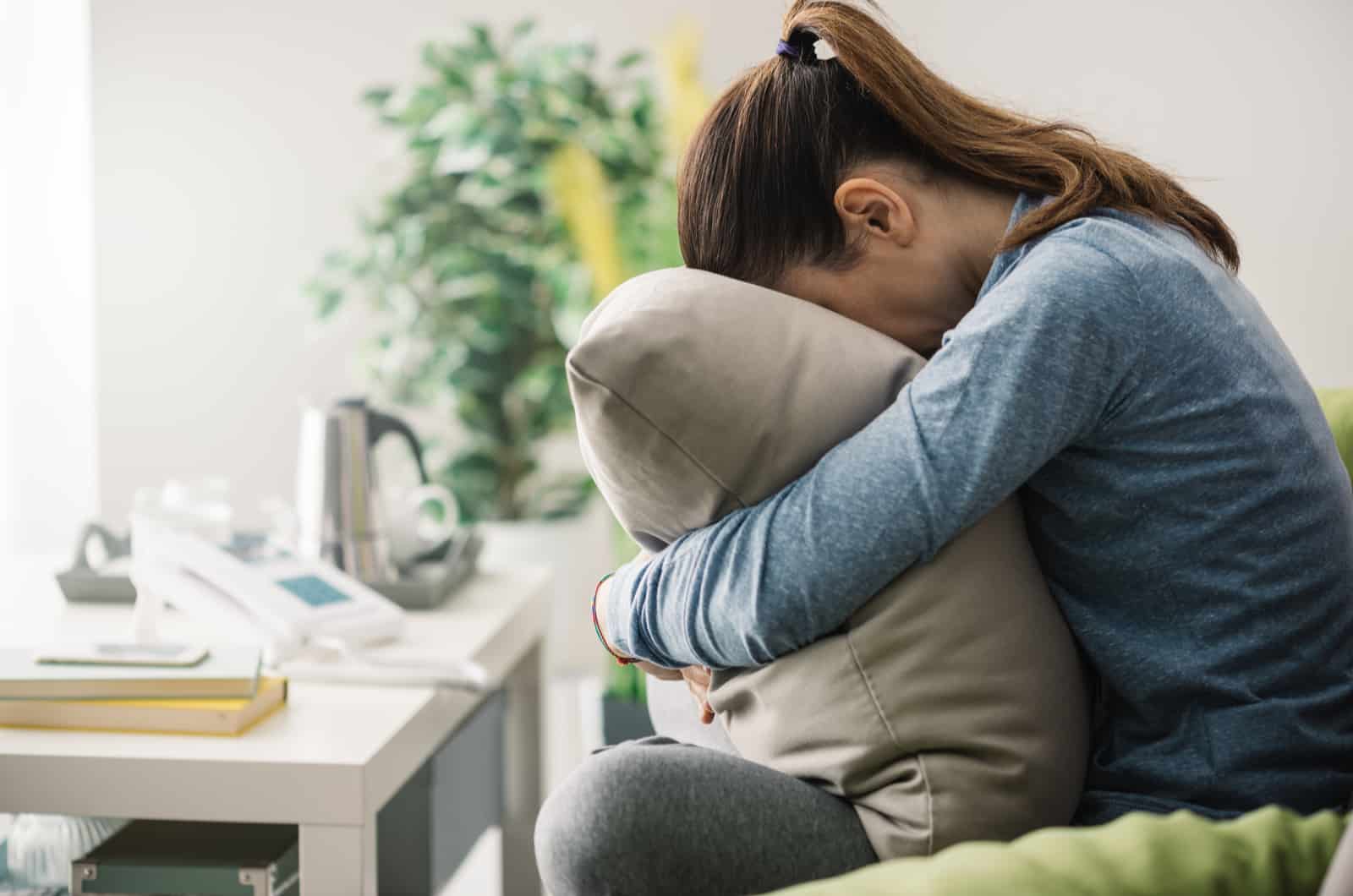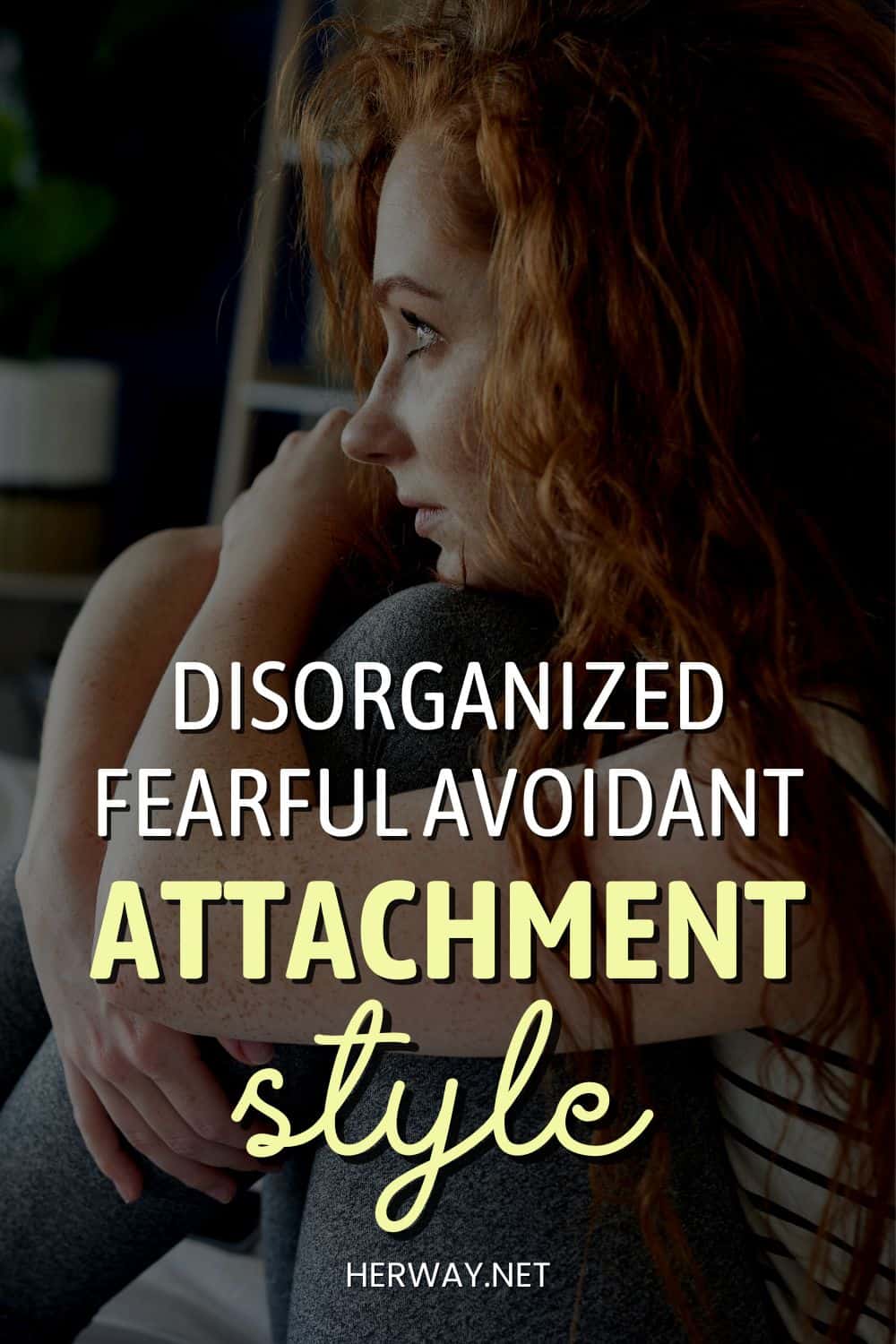Disorganized fearful avoidant attachment style is the rarest and the most challenging among the attachment styles. It’s marked by a craving for deep and meaningful intimate relationships made impossible by fear and avoidance of emotional connection.
This type of attachment can be described as having features of both anxious and avoidant style, resulting in neediness coupled with avoidance. You want to connect to people and you pursue relationships, but as soon as your partner gets too close, you pull back out of fear of rejection.
The most painful aspect of this attachment style is that you always expect to be hurt, but you still can’t help and look for love. You sometimes choose partners who will inevitably make your worst fears come true or you ruin your relationships yourself in fear of what’s to come.
15 Signs Of Disorganized Fearful Avoidant Attachment Style
Disorganized fearful avoidant attachment style is one of three insecure attachment styles. (Terminology concerning attachment styles gets a little confusing, so please refer to the overview of attachment styles below.)
This attachment style can damage your relationships and leave you feeling alone by making you avoid the closeness that you yearn for so much. You’re at risk for social anxiety and depression, and may have trouble seeking relationships altogether.
These are the signs of disorganized fearful avoidant attachment style.
1. Fear of intimacy
People with a dismissive attachment style feel that there’s something fundamentally wrong with them. This stems from the abuse or neglect they suffered. You fear intimacy because you’re afraid that your partner will reject you when they see what you’re really like.
As soon as your partner gets close, you shut down or pull away. Instead of talking to your partner about your relationship, your solution is to leave.
2. Fear of rejection
Disorganized attachment is common in children whose parents had unresolved issues of their own, such as substance abuse, financial issues or disorganized attachment of their own.
Your fear of rejection comes from the feelings you experienced as a child whenever you were asking for comfort from your parents and instead received fear. This is why you’re always waiting for the other shoe to drop in relationships and for your partner to abandon you.
3. Negative view of yourself
You ignore your strengths and focus on your flaws, so your perception of yourself is distorted. This results in feelings of shame about who you are, which drives you to behaviors that hurt you and others, which further confirms your beliefs.
Your negative view of yourself often isn’t rooted in reality, but instead stems from childhood feelings of rejection and other traumatic experiences you’ve been through.
4. Low self-esteem
Negative self-image leads to low self-esteem and this directly influences all areas of your life. Your focus is entirely on yourself and your personal problems, which is another reason why you’re unable to connect to others. You look for people who will confirm your negative opinion of yourself, but you fear how they might expose your flaws.
RELATED: 50 Inspiring Self-Esteem Quotes That Will Boost Your Confidence (And Make Your Day)
5. Feeling unworthy of love
You feel flawed and not good enough to be loved or that you don’t deserve to be. When someone gets close to you, you engage in self-sabotaging behaviors to push them away.
You do it because you feel that, if your partner gets to know the real you, they will reject you anyway. Feelings of being unworthy of love are caused by the trauma you’ve been through, and have nothing to do with reality.
6. Craving love
Even though you feel like you don’t deserve love, you still deeply yearn to have it. However, you don’t know how to deal with relationships once they get past the honeymoon stage and you never learn to manage conflict without escalation.
Your craving for love combined with the belief that you don’t deserve it is what lays behind your behavior in relationships: you push away your partner as soon as they get close to avoid getting hurt.
7. Seeking approval from others
Your self-image is so negative, that the only way you can feel good about yourself is by getting approval from others. This, however, is a short-term solution and quickly becomes insufficient, so you have to continue looking for more ways to get validation. The result of this are various negative behaviors that hurt both yourself and your loved ones.
8. Inconsistency in romantic relationships
Lack of consistency in relationships is a direct consequence of the combination of wanting to get close and simultaneously being afraid of it.
When your partner is unable to predict how you feel and how you will react to their action, it discourages them from opening up. Inconsistency keeps relationships from moving forward, until it eventually drives the other person away.
9. Avoiding commitment
Your belief that if you open up to others you’ll get hurt determines how you act when a partner gets too close. You refuse to commit because you would be giving the other person the power to hurt you. For you, it feels like it’s safer to keep your distance, but eventually this is what ends up hurting you anyway.
10. Internalizing relationship problems
You feel as if you’re to blame for all problems in your relationship. Your deeply-rooted feelings of guilt and shame caused by childhood trauma lead you to believe that you are the reason why you’re not getting love, so in relationships you view problems as proof that you’re unlovable.
11. Abusive relationships
People with a disorganized attachment style are usually involved in unhealthy relationships, which includes being the victim or the abuser in abusive relationships.
Fear of abandonment is one of the factors why their volatile and unpredictable emotions, including anger, can escalate to violence, but that is also why they stay in abusive relationships in which they are the victim.
12. Lack of trust
You believe that you don’t deserve to be loved, so you’re often suspicious of other peoples’ intentions.
Because your caregivers responded by hurting you when you expected them to love you, you’re always expecting the same thing to happen in your other relationships. This results in behaviors such as acting in such a way that it could push away your partner to test them.
13. Inability to empathize
This doesn’t imply a lack of empathy – it shows how you react in situations in which you’re supposed to respond to other people’s feelings.
For instance, when your partner is upset, you become disconnected and, instead of comforting them, you ignore them. This kind of behavior is caused by being overwhelmed and incapable of dealing with your own and other people’s feelings.
14. Inability to communicate needs
You believe that your feelings and needs are irrelevant, so you don’t know how to let people know how you feel or ask for what you need. You have trouble providing support for your loved ones and asking for support when you need it. You avoid expressing feelings and needs out of fear of being judged and ultimately rejected.
15. Unpredictable moods
You interpret situations in a way that reinforces your beliefs, so instead of reality, your actions reflect your fears. Any kind of conflict makes you believe that you’re the problem, that your partner can’t possibly love you and that you’re about to be abandoned.
Your unpredictable moods are also caused because you assume that your partner must know things without you telling them, so when they don’t, you feel let down and act out.
What Is Attachment Theory?
It’s well-known that attachment patterns formed in early childhood greatly affect adult relationships, but this wasn’t always common knowledge.
In the 1950s, psychiatrist John Bowlby examined relationships of babies with their caregivers. He suggested that a child needs a warm relationship with their parents and that the opposite would have negative consequences on the child’s mental health. He developed attachment theory to describe his findings.
Mary Ainsworth, a developmental psychologist, observed how young children behave when they’re separated from their caregivers using an experiment called the Strange Situation Procedure. She concluded that children develop either a secure attachment style or insecure attachment style, depending on whether the attachment figure is available when the child needs them.
Attachment Styles In Children And Adults
Since bonds we make as adults depend greatly on how we form attachment to someone, it doesn’t seem surprising that another team of psychologists decided to research just that: attachment to romantic partners in adult romantic relationships.
Cindy Hazan and Phillip Shaver found that adults also have differences in their attachment styles and that there are four adult attachment styles, corresponding to those exhibited by young children and influenced by early experiences or childhood trauma.
The type of attachment style in adults influences the partners they choose and how they act in relationships. People with insecure attachment styles hold certain beliefs about intimate relationships and they look for partners whose behavior confirms those beliefs.
SECURE ATTACHMENT STYLE
1. Secure attachment
• Secure attachment in children is a result of positive childhood experiences and a close relationship with a caregiver. They can rely on their caregiver to meet their needs.
• Adults with the secure attachment style are comfortable expressing their feelings and easily connect to their partners. They’re comfortable expressing their needs and have a healthy attitude towards relationships.
INSECURE ATTACHMENT STYLES
2. Avoidant attachment style
Other terms used are anxious-avoidant and dismissive-avoidant.
• This attachment style develops in children when their caregiver repeatedly rejects them and fails to meet their needs. The child disguises their distress by avoiding or ignoring their caregiver.
• In adults, the dismissive-avoidant attachment style manifests as emotional distance and self-sufficiency. They hide their low self-esteem and fear of rejection by avoiding emotional intimacy.
3. Anxious attachment style
Other terms for this type of attachment style are anxious-preoccupied and anxious-ambivalent.
• Children develop this attachment style as a reaction to being uncertain whether their caregiver will respond to their needs. They try to influence their caregiver by anger or passivity.
• Adults with the anxious attachment style are clingy, dependent and seek validation in relationships. They have low self-esteem and worry that they’re not good enough for their partners and experience fear of abandonment.
4. Disorganized attachment style
Also known as disoriented attachment style, fearful-avoidant attachment style and disorganized fearful avoidant attachment style, this is the one we’re most interested in today.
• The disorganized attachment style in children is most commonly a response to trauma or abuse.
A child knows that their attachment figure is supposed to meet their needs and provide care and comfort, so when the caregiver hurts the child, it instills in them a sense of fear.
It also happens when the caregiver is unpredictable, such as a parent with substance abuse problem, or if the child experiences loss of their caregiver, or their ‘secure base’.
When a child’s caregivers simultaneously provide comfort and cause fear, the child still looks for closeness, but also no longer trusts them and keeps a distance.
• Adults with the fearful-avoidant attachment style or the disorganized fearful avoidant attachment style want to form emotional bonds but, as a result of unresolved trauma, they avoid intimacy out of fear of getting hurt. Their behavior is inconsistent and they have trouble trusting others.
This attachment style is sometimes present alongside borderline personality disorder, a mental health condition characterized by impulsiveness, unstable relationships, and a hard time controlling emotions.
5 Tips To Overcome Disorganized Attachment Style
One of the dangers of disorganized fearful avoidant attachment style is that when a parent has it, they might repeat the cycle they’ve been through and cause it to develop in their children.
Because they’re distant and have a hard time providing emotional support, their children tend to end up the same way.
To be able to form healthy and secure relationships, you must first establish a healthy relationship with yourself. Dealing with your negative view of your own worth and your insecurities and learning to love and appreciate yourself is the first step towards being able to approach your relationships in a healthy way.
1. Therapy
The most useful thing you can do to overcome disorganized fearful avoidant attachment style is to seek therapy.
Learning to allow yourself to let your partner in and trust them not to hurt you is key to your relationship problems, but the underlying issue is your damaged sense of self-worth. A therapist can help you set boundaries, assist you while you’re working through your negative emotions and guide you towards emotional wellness.
2. Self-awareness
Furthermore, work on developing self-awareness that will enable you to recognize your triggers and control your emotions.
People with insecure styles tend to look for confirmation of their fears from their partners, so being mindful of your feelings can help you identify whether you’re misunderstanding your partners because of your expectations.
3. Learn to understand your feelings
It’s difficult to influence feelings – instead, try to understand what it is that you’re feeling and try to understand why.
Once you’re able to identify what exactly you are feeling and the reason for those feelings, you’ll be able to better control your reactions. If you lashed out at your partner when they canceled your date, you’ll be able to figure out that you reacted that way because you were afraid that they wanted to end things.
4. Confronting negative thinking
Everyone has an inner critic. Yours is telling you things that aren’t true, such as to hate yourself and that you don’t deserve love.
The best way to deal with this is to challenge negative thoughts. Whenever you have a negative thought, try to think of something positive that contradicts it or keep asking yourself questions until you’re able to think of something that proves your negative thinking wrong.
5. Communication
Even though you yearn for intimacy, your attachment style makes it difficult to connect with your loved ones.
Fear of getting hurt only increases the more vulnerable you become, so, understandably, you pull back before you’re able to get close to your partner. Setting boundaries and developing communication skills instead of withdrawing can help you achieve intimacy in a gradual way that feels more safe.
RELATED: I Don’t Deserve To Be Happy: Coping With These Dark Thoughts
In Summary
Dealing with disorganized fearful avoidant attachment style is a constant struggle. Being afraid of getting close to someone while at the same time craving close connections affects you in multiple ways.
Your injured sense of self-worth makes you constantly question your value, giving you a negative view of yourself and making you feel undeserving of love even though you yearn for it. This is why you subconsciously choose partners you believe will fulfill your belief in unavoidable rejection.
In relationships, your behavior is unpredictable or you refuse to enter relationships at all. Because your inability to solve problems in a healthy way extends beyond romantic relationships, you and your loved ones are constantly at the mercy of the rollercoaster of your emotions.
Making an effort to understand your emotional needs and triggers with the help of a professional is the best way to overcome your attachment style and give yourself a chance of experiencing love how you deserve it.








